Hoya carnosa



Woody
Stems and branches with a woody texture commonly associated with shrubs or perennials.
Climbing-twining
A plant that climbs using tendrils or twines around a structure.This epiphytic or terrestrial twiner has slender woody stems with aerial roots and forms a dense cover. It has thick fleshy glossy dark green leaves and the small perfumed star-shaped flowers appear in a pendent cluster from late spring to autumn.
Hoya carnosa is naturally found from south-east Asia to China growing in rainforests in well drained but moist organic rich soils with a pH range from 6.0 to 7.5 or as an epiphytic in trees, preferring moist leaf mould. It prefers a semi shaded to sunny protected humid position and is drought and frost tender.
The Wax Plant is grown for its flowers and climbing habit. It is trained over lattice or wire fences or used in hanging baskets in shaded courtyards. It is also planted near entrances for its perfumed flowers. It is slow growing and will establish in 4 to 7 years and dislikes disturbance. If grown under glass place in indirect well-lit area and apply liquid fertiliser monthly during the growing period. Once established it has a medium water requirement, (Scale: 2-drops from 3) and responds to reliable soil moisture but dislikes waterlogged soils.
I.D. 133.
UK hardiness zone H1b
Climate zones H1, H2, 21 - 24
USDA Zone 10-11
Hoya (HOY-a) carnosa (kar-nosa)
Etymology
Genus: - Hoya – after Thomas Hoy (c.1750-1822), gardener at Syon House
Species: - carnosa – fleshy
Cultivars
'Compacta'
The leaves are twisted upwards in a rolling shape giving it a rope-like appearance and the plant is commonly grown in hanging baskets or as a spill over.
'Crispa'
Hindu Rope Plant
This pendant plant is similar to 'Compacta' and has stems that are tightly covered in convoluted leaves and form a rope-like appearance. It is not a climber and is best suited to hanging baskets or window boxes. During spring it produces clusters of waxy pink flowers amongst the foliage.

Asclepiadaceae (ass-kle-pee-ad-AY-see-ee)
This large family has many widely used ornamental plants.
Distribution
The Asclepiads are normally found in the tropics and sub-tropics with some genera in temperate climates around the world.
Diagnostic Features
These plants may be perennial herbs, shrubs, trees and climbers and may be in a succulent form or have milky sap.
The leaves normally have stipules and are arranges opposite or in whorls with a simple shape, may be vestigial.
The regular symmetrical bisexual flowers are borne on cymes, raceme or umbel-like inflorescence. The flowers consist of five semi-fused sepals and five fused petals with five stamens with short filaments that may be fused to the gynoecium, simular to an orchid flower.
The corolla or stamens may have appendages of different types that constitute a single or double corona.
Stamens have two pollen chambers that form a waxy pollinium these are joined by a filamentous glandular connection and the pollinates remove pollen on mass rather than singular.
The gynoecium may be superior or inferior and is composed of two carpels that are held together by the style or a five lobed stigma. Each carpel contains rows of ovules on a single placenta.
The fruit forms into a pair of follicles or capsule, which opens longitudinally and has flattish seeds with silk hairs to assist in wind dispersal. The embryo straight and has endosperm.
Note:
Many of these ornamental plants are grown in gardens or containers for their showy flowers. Some Australian species are eaten or the sap was used to decorate in body art.
This plant tolerates between USDA zones 10a to 11a and grows to 3 m (9 ft)
Fahrenheit 30ºF to 45º F
These temperatures represent the lowest average
Celsius -1.6ºC to 7.2º C
Attention
All photographs and data are covered by copyright. Apart from any fair dealing for the purpose of private study, research, reference or review, as permitted under the Copyright Act, no part may be reproduced by any means with out written permission. All inquiries should be addressed to plantfile.com attention Peter Kirkland.

Simple
The leaf that is not divided.
Elliptical
A leaf that tapers equally at both ends. Broadest at the middle.
Opposite
Leaves that are arranged opposite to each other.
Entire
A leaf margin with no irregularities (smooth).
Stellate
When the petals radiate from a common centre forming a star-shape.
Umbel
When the pedicels arise from the same point on the peduncle.| Jan | Feb | Mar | Apr | May | Jun |
| Jul | Aug | Sep | Oct | Nov | Dec |
The outer part of the 5 mm (¼ in) wide stellate flowers is white with inner pink. They are arranged in a dense umbel that has 12 to 30 blooms with pedicels that are up to 50 mm (2 in) long. The sweetly scented flowers appear on the same spur every year from early to mid summer. Do not pick the flowers as it may damage the spur which increases in length with each successive flowering cycle and avoid pruning stems.

Capsule
A dried dehiscent fruit, with an enclosing membrane normally containing may seeds."The Wax Plant is grown for its scented pendent flowers and climbing habit. It is trained over lattice or wire fences or used in hanging baskets in shaded courtyard. It is also planted near entrances for its perfumed flowers but is slow growing and will establish in 4 to 7 years. If grown under glass place in indirect well-lit area and apply liquid fertiliser monthly during the growing period.
Note:
Hoya's require a temperature of 12.7º C (55º F) during winter and prefer a brightly indirect light to full sun, with protection from hot mid afternoon sun. The soil must be well drained and fertile. During summer watered regularly, allowing the surface to dry before re-watering and reduce watering in winter.
They prefer a humid environment but avoid misting the plant during the flowering period. Re-pot only as necessary during spring.
Take cuttings of previous season's wood during late spring to summer and place in a sand / peat mix with bottom heat.
Take leaf cuttings during late spring to summer.
Asexual Propagation (Cuttings general)
Propagation from cuttings is possible because every cell of a plant containers the genetic information to create an entire plant.
1. Reproduction occurs through the formation of adventitious roots and shoots.
2. The uniting of vegetative parts with budding and grafting.
3. Taking stem cuttings and layering is possible due to the development of adventitious roots
4. Root cuttings can form new shoots and it is possible to join roots and shoots to form a new plant.
5. A new plant may be formed from a single cell in an aseptic culture system, (cloning).
It is important to propagate vegetatively as this form of cloning retains the unique characteristics of the cultivars or where particular aspects of a plant may be lost if propagated by seed.
Equipment Required for Taking Cuttings
1. A sharp knife that is not too large or a razor mounted in a handle.
2. Good pair of sharp secateurs that is clean.
3. A dibbler to make a hole in the media and allow the cutting to be placed in.
4. Propagation structures that are either a timber frame with glass or polyethylene cover or a glasshouse.
The object of the structure is to create an environment where the temperature and humidity can be controlled. This can be achieved with a simple cover over a pot with a wire frame and plastic.
This stops the draughts and maintains humidity.
5. A hotbed is a useful item as many plants root more quickly if the media is slightly warmer.
Bottom heat is obtained from thermostatically controlled heating cables that are running under the media.
6. Misting systems are of great benefit to cuttings as the regulated fogging with water inhibits the cuttings from drying out and as a result the cuttings may be grown in full sun.
This results in faster root development and less subject to diseases by fungi and bacteria.
7. Rooting mediums
The rooting medium must be well drained, sand may be used as long as it is thoroughly washed and leached of all salts. It is very well drained and it is excellent for cutting that root up quickly. Equal parts of sand and peat moss have good results for cuttings, which are left for a period of time to allow the roots to form.
Vermiculite and perlite are also used as a well-drained rooting media but has the same disadvantage as sand having no nutrients. The cuttings must be potted up as soon as the roots developed, or a light application of liquid fertiliser can be applied.
Types of Cuttings
Stem cuttings
These are the main types of cuttings.
1. Softwood cuttings
These cuttings are taken from young growth on side shoots and tip growth.
2. Semi hardwood cuttings
These cuttings are taken from wood that is firmer and semi ripe usually during mid summer.
3. Hardwood cuttings
These cuttings are taken from mature wood normally towards the end of the season.
4. Root cuttings
Cut sections of roots to obtain new plants during late winter to early spring.
5. Leaf cuttings
Cut the leaf blade in order to obtain new plants during the growing period of the plant.
Cutting preparation
Hardwood cuttings
When taking hardwood cuttings remove the leaves and in semi hardwood reduce the number of leaves by half. Cut the wood straight across just below a node or joint. Hardwood cuttings are normally between 100 to 760 mm long and may have either a heel of the older wood attached to the base, or a short section of the older wood at the base. These cuttings are prepared during the dormant season from late autumn to early spring and are made up from previous season's growth.
This type of cutting is used for woody deciduous plants such as Crepe Myrtle, Rose rootstocks and some fruit trees.
The cuttings should be healthy wood with ample supply of stored food as to nourish developing roots and shoots and placed in the rooting media with the aid of a dibbler stick.
Softwood cuttings
The cuttings for softwood should be 60 to 130 mm long and be of material with enough substance as to not deteriorate before the new roots appear. Cut below a node and retain the leaves on the upper portion. Place in a well-drained media and maintain a high humidity.
Soaking the cuttings and leaving them standing in water for long periods is undesirable.
Herbaceous cuttings
These cuttings are taken from succulent plants such as Geraniums and Coleus. The cutting should be 70 to 130 mm long with leaves retained on the upper end. As in softwood cuttings these require an environment of high humidity. Some fleshy cuttings ooze sap and may require a drying period for a few hours before being placed in the rooting media.
Leaf cutting
In these cuttings a leaf blade and petiole or part off is used to raise a new plant. The original leaf doses not become a part of the new plant as roots and shoots appear from the base of the leaf. In some cases roots appear from the severed veins.
Leaf-Bud cuttings
These cuttings incorporate a leaf, petiole and a small piece of the stem. These cuttings are an advantage where the plant uses the axillary bud at the base of the petiole for new shoot growth and maximises available propagation material, as each node will produce a new plant.
As in softwood cuttings these require an environment with high humidity and warmth.
Root cuttings
These cuttings are best taken from younger plants during late winter to early spring prior the new season's growth unless the dormant period is during summer.
Trim the roots as they are dug up and to maintain polarity cut strength at the crown end and a slanted cut at the distal end (away from the crown).
Root cuttings of small plants are placed in flats in lengths of 20 to 50 mm and laying horizontally on the surface of the soil. These may be lightly covered with sieved sand or media, watered and then placing a piece of glass or polyethylene over the container till roots / shoots appear.
Fleshy root cuttings
These cuttings should be 50 to 75 mm long and placed vertically in a well-drained sand media.
Keep the polarity correct and when the roots develop transplant the cuttings into a separate container.
Large root cuttings
These cuttings are 50 to 150 mm long and are tied up in bundles and placed in boxes of damp sand, sawdust or peat for about three weeks at a temperature of 4. 5 deg C. When taken out they should be planted in a prepared bed 50 to 80 mm apart with the tops of the cuttings level with or just below the soil level.
PEST
NAME
Mealybugs
Various Mealybug Species
ORDER
Hemiptera
FAMILY
Pseudococcidae
Description of the Pest
Adult females are 3-5mm long, flattened oval-shaped white insects, which secrete a white, mealy wax that forms a row of hair-like filaments of fairly uniform length around the edge of the body; the hind end bears one or two pairs of filaments that are longer than the others. They are mobile but slow-moving. The seldom-seen adult males are tiny winged insects with a pair of long waxy tail filaments. Early stage nymphs are tiny, pink and mobile; later stages resemble adult females.
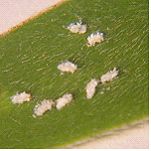
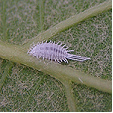
There are many types of mealybugs including;
· Longtailed Mealybugs (Pseudococcus longispinus) generally have tail filaments that are longer than there body. If squashed yellow body fluid is revealed and the eggs are laid under the body and normally hatch immediately.
· Citrus Mealybug (Planococcus citri). This insect has tail filaments that are less than 1/3 the length of its body. It produces yellow orange body fluid and lays eggs in a cottony mass.
· Citrophilous Mealybug ( Pseudococcus calceolariae). This insect has tail filaments that are about 1/3 the length of its body. It produces dark red body fluid and the eggs are laid in a cottony sac.
· Root Mealybug (Rhizeocus falcifer). This insect is not normally seen but produces a open white mass as it feeds on the outer or terminal roots, normally container plants, particularly cacti species. The eggs are laid in the waxy mass and adults may dispersed by ants.
· Hibiscus Mealybug (Maconellicoccus hirsutus)
· Tuber Mealybug (Pseudococcus affinis)
The Mealybugs (Pseudococcus adonidum) and (Planococcus citri) are a major pest of cacti species, sucking sap and turning the infected area yellow. These pests are also found on Strelitzia, Camellia and Yucca species.
Appearance and Distribution of the Pest
Mealy bugs are found worldwide. The above ground species are found in sheltered areas such as under a leaf or in leaf bases. They are also found where two fruits or leaves touch and are not readily noticeable.
The below ground species are only found when a plant is re-potted or the infected plant wilts and dies. Mealybugs are distributed several ways including slowly walking to a new host or transferred on clothing, contaminated plants or strong wind and on visiting insects. They are also farmed by ants which in a nursery situation infest pots by tunnelling and carrying mealybugs to the roots.
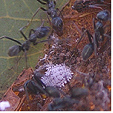 Attending Ants
Attending Ants
Life Cycle
These insects have a Hemimetabolous life cycle, ie. When the immature nymphs resemble the adults.
Up to 200 young are produced in 2-3 weeks; eggs may hatch as they are being laid. The life cycle includes eggs, nymphs (3 to 4 stages) to adult takes 6 weeks, in warmer months; several generations appear throughout the year.
Period of Activity
Active all year, particularly in spring and autumn. Warm, humid conditions are preferred and the insect overwinter outdoors as eggs. These may be found on surrounding weeds. In Citrus species many longtailed mealybugs overwinter as juveniles, maturing during spring. In a Glasshouse conditions mealybugs are active through the year.
Damage Caused
Adults and nymphs suck sap, congregating in sheltered parts of the plants; some species feed undetected on roots. Early infestations may go unnoticed until the plant begins to wilt. The insect also produces honeydew, which gives rise to sooty mould.
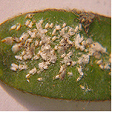
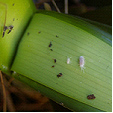 Clivia miniata
Clivia miniata
Susceptible Plants
Mealybugs are found on a wide variety of trees and shrubs. They are also destructive to many ornamentals; including indoor plants (especially African violets and ferns), and are a major greenhouse pest.
Cactus species
Many species of mealybug are common pest of cactus and succulents. The small, grey to light brown mealy bugs are difficult to see amongst the spines. Nesting females appear as the small balls of white fluff on cactus spines or around the base and under the rim of the pots. The female will produce eggs or living nymphs and the insect will produce honeydew that attracts ants. Ants should be discouraged as they farm mealy bugs, moving them from one place to another in a cactus collection.
Cactus is also attacked by the root mealybugs that infest the roots of plants and their damage allows fungal and bacterial infections to enter the plant tissue. They can be identified by white fluffy deposits in the soil or underneath a pot and appeared as tiny pinkish brown wood lice up to 3 mm long.
Catalpa species are susceptible to the mealybug (Pseudococcus comstocki) which is a wax covered mealybug that causes distorted growth of the branches and branchlets.
Fern species are commonly attacked by mealy bugs and can be recognised by small white, waxy secretions as it feeds in the crevices at vein junctions or on the exposed rhizome.
Hedera and Crassula species are susceptible to three species of mealybugs including Citrus Mealybug (Planococcus citri) and not normally requiring control.
Laburnum anagyroides is infested with the Grape Mealybug (Pseudococcus maritimus) infesting the branches and twigs.
Plumeria acutifolia becomes infested with mealybugs on the new growth but normally control is not required.
Psidium species are attacked by the Longtailed Mealybugs (Pseudococcus longispinus).
Sequoia species are attacked by three species of Mealybugs including (Planococcus citri).
Thymus species are attacked by the Root Mealybug (Rhizeocus falcifer).
Thuja species Cupressus macrocarpa and Araucaria heterophylla are can be infested with the mealybugs (Pseudococcus ryani).
Turf Grass may be infested with mealybugs causing severs damage and often go undetected and build up large colonies quickly. The turf forms brown dry patches and looks simular to Dollar Spot the infestation may also occur around core holes and can be discouraged by generous watering. Agrostis palustris (Bent) and Cynodon species (Couch) are commonly attacked.
Yucca species are attacked by the mealybug (Planococcus citri).
Cultural Control
Small plants may be sprayed with a soapy water solution or sponged down preferably during the evening. Heavily infected areas should be pruned and destroyed or the whole plant removed. Infested pot-plants should be discarded and thoroughly disinfect pots before recycling). Maintain vigour by watering to replace sap loss, this helps infected plants to recover.
As a preventative measure for root mealybugs grind up mothballs and add them to the potting mix to discourage infestations. Care should be taken as the chemicals in mothballs can damage plastic pots (use clay pots) and in some countries such as the UK. mothballs must be used as directed on the label.
Biological Control
Lacewing and ladybeetle larvae (Cryptolaemus montrouzeri) control small infestations. This predator insect requires temperatures of at least 21° C. (70°F) and in small infestations it is difficult to maintain a balance between predator and prey.
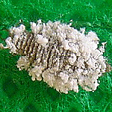
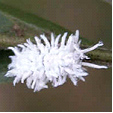
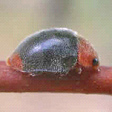
Ladybird beetle larvae eats Mealybugs Ladybird beetle up to 4 mm long
Chemical Control
Spray with white oil may have an effect on the population or spray Omethoate. Contact insecticides are usually ineffective because of the insect's protective waxy coating.
Note
Always read the label for registration details and direction of use prior to application of any chemicals.
PEST
NAME
Scale Insect
Various Scale Species
ORDER
Hemiptera
Description of the Pest
Generally scales are soft bodied insects that have a hard (armoured) or soft covering to hide under. They have piercing and sucking mouth parts that are attached to the host, feed off sap and soft scales commonly producing sweet honeydew, which in turn attracts sooty mould and ants.
The adult female has a circular or oval covering depending on the species and is up to 8mm across. The first stage (crawlers) hatch and wander around the leaf surface until finding a suitable place to suck sap, normally in colonies and the smaller male is relatively inconspicuous.
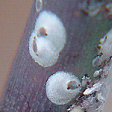 Hard Scale
Hard Scale 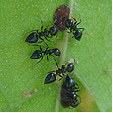 Soft Scale, attending Ants
Soft Scale, attending Ants
Cactus Scale (Diaspis echinocacti) has a circular greyish female and a narrow white male scale and is commonly found on house plants.
Chain Scales (Pulvinaria species) adult females are obvious with large group of eggs that are white or cottony-like, and the tiny young light green scales are flat and oval-shaped up to 2mm long. The legged nymphs are normally arranged from head to tail along the mid rib of the leaf, and may move to a new position to feed. They excrete honeydew and attract sooty mould and are found on Acacia and Acronychia species.
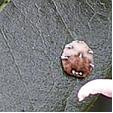 Chinese Wax Scale
Chinese Wax Scale
Chinese Wax Scale (Ceroplastes sinensis) is a domed wax scale that has dark spots around its margin and immature scales form waxy material around there margins.
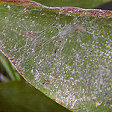 Fern Scale on Aspidistra elatior
Fern Scale on Aspidistra elatior
Fern Scale or Coconut Scale (Pinnaspis aspidistrae) appears as flecks up to 0.15mm long with a white covering over the male congregating on the underside of the fronds on the axils and among the sporangia causing them to turn yellow. Many species of fern are susceptible to infestation.
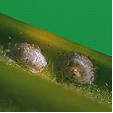
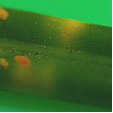 Flat Brown Scale
Flat Brown Scale
Flat Brown Scale (Eucalymnatus tessellates) are light brown up to 0.5mm long, flat and closely attached both sides of the leaf and causing yellowing of the foliage.
Juniper Scale (Diaspis carueli) is tiny and circular, white maturing to grey-black and as it feeds the needles turn yellow and die.
Oleander Scale (Aspidiotus hederae) is a pale yellow circular scale up to 3mm across and is found in dense colonies on the stem or leaves.
Tea-tree Scale (Eriococcus orariensis) are a creamy blue colour normally packed along the branches and are plump and rounded to 4mm across.

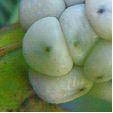 Wattle Tick Scale
Wattle Tick Scale
Tick or Wattle Scale (Cryptes baccatus) adult is domed, blue-slate colour with a leathery covering up to 10mm long. All stages of growth are found in groups of over forty, packed along the stems and normally tended by ants as they produce large amounts of honeydew. A serious pest of Acacia species found inland or coastal from temperate to sub tropical climates and commonly accompanied by Sooty Mould.
Toxic Scale (Hemiberlesia lataniae) is a tiny flat rounded scale up to 0.15mm long and is white to pale pink. It is normally found in colonies on the small branches and twigs of shrubs. It injects a toxic substance into the host as it sucks sap causing the death of the branch.
Wattle Scale (Pseudococcus albizziae) is soft, plump and secrets cotton-like threads. It is not a true scale insect and is simular to mealy bugs. It is reddish-brown up to 0.4mm long and secrets large amounts of honeydew as it sucks sap in colonies along the branches.
Life Cycle
These insects have a Hemimetabolous life cycle, ie. When the immature nymphs resemble the adults.
Appearance of the Pest
All parts of the plant above the soil may be attacked, but normally the stems and leaves and scale tends to favour well-lit positions.
Period of Activity
The nymphs and females are active for most of the year, in warm climates. Once they selected a position they attach and don't move. Normally the winged or wingless males are mobile and only soft scales produce honeydew.
Susceptible Plants
There is a wide range of susceptible plants including citrus, willows, holly, and many ornamentals, such as roses or Paeonia species. It also attacks indoor or glasshouse plants and Australian native plants such as wattles, hakeas, grevilleas and eucalyptus.
Acacia species are attacked by the Tick or Wattle Scale, which infest twigs and small branches and heavy infestations will kill the host plant.
Acer species are attacked by the Cotton Maple Scale (Pulvinaria innumerabilia) which prefers Acer saccharinum. Nymphs first attack the leaves and the brown adult scale is covered in a woolly mass up to 14mm across, normally found on the underside of the stems and twigs.
Acmena smithii, Melaleuca, Syzygium and Pittosporum species are attacked by the Chinese Wax Scale.
Aesculus species are attacked by several scale insects including the Walnut Scale (Aspidiotus juglans-regiae) which is saucer-shaped and attacks the main trunks.
Agave species are susceptible to several types of scale including (Aspidiotus nerii), (Aonidiella aurantii) and (Pinnaspis strachani), but generally do not require control.
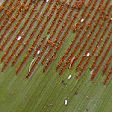 Asplenium australasicum
Asplenium australasicum
Asplenium australasicum is susceptible to Coconut Scale or Fern Scale (Pinnaspis aspidistrae). It is normally found on the under side of the fronds. Small infestations cause little damage.
Bougainvillea species may be attacked by the soft scale (Coccus hesperidum) outdoors or under glass.
Calluna and Vaccinium species are attacked by the Oyster Shell Scale (Lepidosaphes ulmi).
Camellia species may be attacked by the Florida Red Scale (Chrysomphalus aonidum), which is small, circular and black and is found firmly attached to the underside of the leaf along the veins. On inspection after removing the scale the insect has a pale yellow body. Camellias are also attacked by a large variety of scale insects including Tea Scale and Camellia Scale.
Carpinus species may be attacked by the scale (Phenacoccus acericola). It is found on the underside of the leaves forming a white cotton-like clump along the veins.
Casuarina and Allocasuarina species may be attacked by the Casuarina Scale (Frenchia casuarinae), a black hard scale that is upright to 4mm with a pinkish body. During attachment the surrounding tissue swells up and in time can, form galls. This weakens the wood and in severe infestations may kill the tree.
Cotoneaster species are attacked by up to four species of scale including the Oyster Shell Scale (Lepidosaphes ulmi).
Cupressus species are attacked by Bark Scale (Ehrhornia cupressi) is pink and covered in white wax. Heavy infestations cause the leaves to turn yellow or reddish.
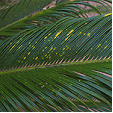 Flat Brown Scale on Cycas revoluta
Flat Brown Scale on Cycas revoluta
Cycads, palms and some species of Callistemon are attacked by the Flat Brown Scale.
Erica species are attacked by several species of scale including, Greedy, Oleander and Oystershell scale.
Jasminum species can be infested with up to twelve types of scale.
Juniperus x media and other conifer species are attacked by the Juniper Scale.
Leptospermum species are attacked by the Tea-tree Scale which produces ample honey dew that promotes sooty mould.
Palm and Fern species are susceptible to attack by the Coconut Scale or Fern Scale (Pinnaspis aspidistrae) which infests the underside of the leaves. They are also hosts for many other scale species such as red, cottony cushion and tea scale.
Pinus species are attacked by several species of scale including the Pine Tortoise Scale (Toumeyella numismaticum) and the Red Pine Scale (Matsucoccus resinosae).
Polygonum odoratum is attacked by a small brown scale.

Sorbus aucuparia is attacked by a five species of scale insect, including Black Cottony Maple, San Jose and Scurfy. Generally they suck on the sap of the new growth and leaves.
Strelitzia species are attacked by the Greedy Scale (Aspidiotus camelliae).
Damage Caused
Leaves become yellow and are shed prematurely and there may be twig or stem die-back. When the infestation occurs on fruit, the fruit is small and its skin becomes pitted and cracked. Small trees and saplings that are heavily infested may be seriously damaged or die. Sooty mould can cover fruit or leaves causing a secondary problem.
Cactus Scale can completely cover the host cactus sucking sap and causing it to die.
Cultural Control
Dead or damaged parts of the plant should be removed and destroyed including fallen fruit. Small infestations may be removed by hand or squashed on the stems. Healthy plants are less susceptible to attack, so maintain vigour of the plant and avoid using high-nitrogen fertiliser that produces excessive soft young growth.
When pruning susceptible plants paint the cuts with antifungal sealant paint as scale insects are attracted to the sweet smell of the sap. This will reduce the infection rate of the plant.
Biological Control
Natural predators such as parasitic wasps may reduce numbers of active nymphs; parasitic wasps are bred commercially in some areas for this purpose. It should be noted, however, that wasps would avoid dusty conditions.
Other predators that assist in control are assassin bugs, ladybirds, lacewings, hover flies and scale eating caterpillars. A variety of birds also attack scales.
The control of ants that transport aphid from one host to another also reduces infestation and can be carried out by applying at least three greased bandages 5mm apart around the stem or trunk of the plant.
Chemical Control
Spray the entire plant with dilute white oil solution; a follow-up spray may be required after four weeks, for heavy infestations. Spraying of chemicals will also kill of natural predators and in some cases the secondary scale infestation is more prolific especially when using copper based chemicals.
Some chemical controls, such as methidathion, are available - please seek advice from your local nursery as to the suitable product for your area.
Note
Always read the label for registration details and direction of use prior to application of any chemicals.
DISEASE
NAME
Sooty Mould
Various Sooty Mould Species
Description
A fungal problem related to honeydew that is secreted from other insects. The fungus will not infect the host plant.
Symptoms
A soot-like dry black fungus appears on areas of the plant where honeydew is found. The fungus spreads and becomes thick restricting the plants capability to photosynthesize. The fungus can also appear on fruit spoiling its appearance and gives the plant an unattractive look.
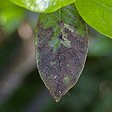
 Gardenia augusta
Gardenia augusta
Source and Dispersal
It is found on other infected plants and soon spreads by wind to other susceptible plants.
Favoured Conditions
It is occurs when insects are producing honeydew, normally through the growing period.
Affected Plants
These fungi can found on most plants particular plants that are infected with scale insect that produces honeydew.
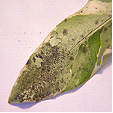 Pittosporum eugenioides
Pittosporum eugenioides 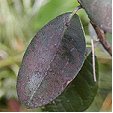 Camellia japonica
Camellia japonica
Callicarpa species are infected with Black Mould (Meliola cookeana) with its black mycelium growing on all parts of the plant including twigs and leaves.
Non-chemical Control
To reduce sooty mould it is required to controlling insect numbers on the plant. Affected plants may have the dry sooty mould rubbed or hosed off.
Chemical Control
Fungicides are not required, but the control of the insect producing honeydew is required.
Note
Always read the label for registration details and direction of use prior to application of any chemicals.
DISEASE
NAME
Sunscald
Environmental (Sun)
Description
Excessive or sudden direct light on the plant combined with high temperatures.
Symptoms
Central parts of the leaf become burnt turning the areas yellow. This area soon becomes brown to black causing the death of the leaf. In climates where it snows unripe wood is damaged by hot spring temperatures in conjunction with Winter Damage. In this case the leaves and stems turn reddish from the excessive cold and when temperatures increase transpiration is inhibited by the frozen soil and poor leaf development, resulting in die back.
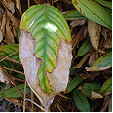 Ctenanthe oppenheimiana
Ctenanthe oppenheimiana  Aucuba japonica
Aucuba japonica
Favoured Conditions
Hot mid day, full sun exposure to plants that normally are protected, or excessive heat waves that cause damage to plants which otherwise tolerate full sun. Plants are most susceptible during spring as the new growth develops.
Affected Plants
All plants can be damaged from Sunscald.
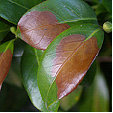 Camellia species
Camellia species
Camellia reticulata and Camellia japonica are sensitive to excessive light turning the leaves brown and Camellia sasanqua is less venerable.
 Banksia robur
Banksia robur 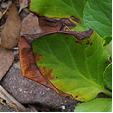 Bergenia x schmidtii
Bergenia x schmidtii
Hoya and Buxus species, Aucuba japonica, Banksia robur and Bergenia x schmidtii are also sensitive to excessive sun.
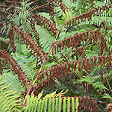 Cyathea australis (Tree Fern)
Cyathea australis (Tree Fern)
Ferns are particularly susceptible to variations in light intensity, combined with high temperatures.
Non-chemical Control
Select plants that tolerate full sun, or protect existing plants from excessive light.
Chemical Control
Not applicable in this case.
DISEASE
NAME
Fungal Leaf Spot on Camellia
Pestalotiopsis and other species
Description
This fungus is a secondary pathogen attacking only dead tissue.
Symptoms
Damaged leaf tissue becomes sunken with a grey colour, papery-like and small black fruiting bodies appear on the surface. Normally it is not widespread on the plant.
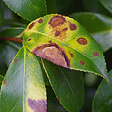
Spot Disease (Pestalotia guepini) forms irregular spots with defined borders that meld giving the leaf surface a silvery appearance. Within the damaged areas black fruiting bodies appear and badly infected leaves fall prematurely.
Source and Dispersal
This fungus originates from other infected plants and the spores are spread by wind.
Favoured Conditions
There are no specific favoured conditions but fungus usually prefers a humid environment.
Affected Plants
Pestalotiopsis species is most commonly found on Camellia Japonica but will also attack other ornamental plant species such as Hoya carnosa.
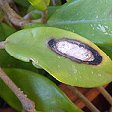 Hoya carnosa
Hoya carnosa
Camellia species are also infected by several fungal leaf spots including (Phyllosticta camelliae), (Phyllosticta camelliaecola) and (Sporonemaa camellia).
Non-chemical Control
Remove and destroy affected leaves including fallen leaves under the plant.
Chemical Control
No satisfactory chemical control.
Average Lowest Temperature : 15º C 59º F
USDA : 10, 11
This USDA (United States Department of Agriculture) hardiness zone chart can be used to indicate a plant’s ability to withstand average minimum temperatures. However, other factors such as soil type, pH, and moisture, drainage, humidity and exposure to sun and wind will also have a direct effect on your plant’s survival. Use this chart only as a guide, always keep the other factors in mind when deciding where, when and what to plant.
A plant's individual USDA zone can be found in the Plant Overview.
Climate Description
Tropical
This zone may be affected by the monsoon or have high rainfall periods. Summer temperatures and humid with mild winters.
Frosts and droughts rarely occur. High winds are accompanied with rain.
Plant growth
Tropical native and exotic plants grow well.
| Dictionary | Growth Habit |
| Leaf Type | Botanic Flower Description |
| Leaf Shape | Flower Inflorescence |
| Leaf Arrangement | Fruit Type |
| Leaf Margin | Bark Type |
| Leaf Apex And Bases | Flower Description |